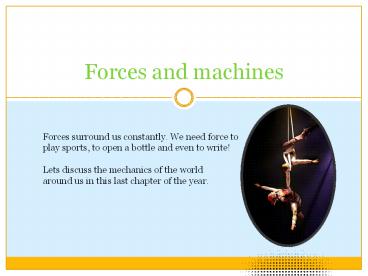Forces and machines - PowerPoint PPT Presentation
1 / 22
Title:
Forces and machines
Description:
Forces and machines Forces surround us constantly. We need force to play sports, to open a bottle and even to write! Lets discuss the mechanics of the world – PowerPoint PPT presentation
Number of Views:202
Avg rating:3.0/5.0
Title: Forces and machines
1
Forces and machines
Forces surround us constantly. We need force to
play sports, to open a bottle and even to
write! Lets discuss the mechanics of the world
around us in this last chapter of the year.
2
Forces
- Discussion in class
- If you are riding a bus and suddenly, the bus
comes to a stop. What do you feel? - If you take the elevator, how do you feel if you
go up? Or down? - In a game of tug-o-war
- Now think about your favorite sport. What kind of
forces does it entail? - There is also a push or a pull.
3
Force
- The symbol of force is F and the unit of
measurement is newton or N ex 5 N ou 20 N - A force is a mechanical action that sets an
object in motion. - A force can change the speed and trajectory of an
object already in motion. - It can also deform an object.
- Ex - Throw a baseball
- Skating
- Push (or pull) a drawer
- Compress a sponge
- Etc.
4
Types of forces (p 410)
- We will discuss a few different types.
- Compression it is a force applied to compress an
object. It can provoque or modify and objects
motion. - Ex compressing a balloon!
- Also, the muscles in your arm must
- compress to lift objects.
- Torsion the action of compressing in rotation
- direction
5
- Tension the force applied to pull an object in
one direction. (especially on a rope) - Ex Such as in the game of tug-o-war or like the
acrobats. - Flexion When an object is pulled and pushed at
the same time. - Shearing When you pull on opposite direction to
tear something - Friction It is a force that slows down or stops
the movement or motion) between two surfaces. - Friction acts in the opposite direction of the
motion. - Ex Your shoes have rubber, so you dont stop and
fall. - Also the tires from a car.
- Air resistance is also a source of fricftion.
6
Observe
What is the purpose of a zamboni?
To reduce friction between the skates and the
ice.
7
Air friction
What is the difference between these vehicles?
8
Aerodynamic cars and cats! (cheetahs)
All have a slender body, which makes for less air
friction
http//www.youtube.com/watch?featureplayer_detail
pagevKIeXEiJuJUY
9
The consequences of forces
- Elastic deformation ex trampoline (takes its
original shape). - Permanent deformation excan of soft drinks that
changes shape (it will take any shape, different
from the initial shape) - Rupture material breaks like the cables of the
Olympic stadium.
10
Types of motion
WHAT DO THESE 3 SYSTEMS HAVE IN COMMON?
11
WHAT DO THESE 4 SYSTEMS HAVE IN COMMON?
12
WHAT DO THESE 3 SYSTEMS HAVE IN COMMON?
13
Movement of translation
- Definition
- The translational movement is the movement that
an object or part of an object does in a straight
line.
14
Motion of rotation
- Definition
- It is the type of movement that a piece of an
object or the entire object will do around an
axis. - Sometimes the rotation is partial
- Part of the object is immobile, while the other
part rotates. - Ex a door handle
15
Helicoidal motion
- Sometimes in some objects rotation and
translation are combined. Thus creating a
movement that looks like a spiral.
16
Newtons laws of motion
Newton, is a british physist, born the year
Galileo died. He attended Trinity College at
University of Cambridge in 1661, he did his own
research and taught while he was still a student!
His work "Philosophiae naturalis principia
mathematica", was published in 1687, has three
sections and contains the universal law of
gravity and the famous Newtons laws of motion.
17
Do you like roller coasters?
18
Newtons first law of motion
- The first law, also known as inertia, states that
all objects tends to remain in the same speed and
direction it was moving at (even at rest) unless
an outiside force acts upon it.
In a roller coaster, the train keeps moving until
the breaks are applied.
19
The first law another example
The golf ball remains at rest until an outside
force acts upon it.
20
Newtons second law of motion
All acceleration of an object is proportional
with the forces applied on it. All acceleration
is inversely proportional to the mass.
Examples of acceleration
Example 1 The more we pull on a rope at
tug-o-war, the more we accelerate. Example 2 A
person pushing a table, is not the same as three
pushing a table. The three together will
accelerate way more!
Examples with mass If these same three people
applied the same force on a car, they wont
accelerate as much. Because its a lot heavier.
21
Newtons third law
To every action, there is an equal and opposite
reaction
22
The second and third laws applied on roller
coasters
2nd law
3d law
The force that we feel from the gravity as we
free fall from a very big height is enormous and
can be calculated Using F mxa m mass of the
train and passengers. a gravitational
acceleration (g) 9.8 m/s2
The roller coaster undergoes curves that you can
feel. When the train goes in a curve we feel like
the seats are pushing us. But you are also
pushing the seats with an equal and opposite
force. Which helps you to hold on to your seat!































